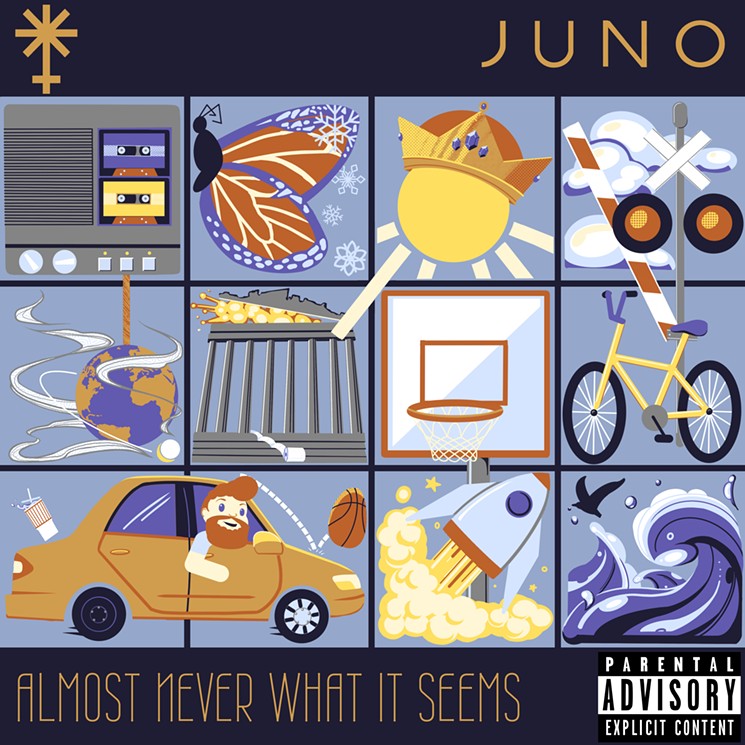Many in the Houston theater community might know actor and director Robert Meek from his collaborative production work with Rec Room and Landing Theatre. Fewer people may know Meek’s new musical alt-identity, Juno (stylized as “J U N O”), a newly devised hip-hop persona developing his identity in the shadow of the Bayou City skyline.
Where’d the name come from? Meek says space imagery grabbed him while researching other projects. “There’s the Juno satellite that takes the most gorgeous pictures of Jupiter you’ve ever seen, those images were always really inspiring to me when I was making beats in my one bedroom apartment. So part of the naming came from that. The Juno icon is actually the icon for the goddess Juno. I found the Juno symbol just when I was looking up iconography for it. I was just like: 'Ooh, that’s cool!' And it became the symbol.”
With the November release of Juno’s second album entitled Almost Never What It Seems, Meek appears proud to have developed the album during the prolonged pandemic. “It was really interesting, when COVID first happened we weren’t really sure about what the impact was in early March, everyone was off quarantining. So [me and co-collaborator Dillon D] locked ourselves in the studio for like, a week. We did five days straight: we made a song a day. And almost every song we made during that time ended up on the album! It really was the genesis of the album coming together.”
Along with the addition of singer-songwriter Dillon D (Dillon Dewitt), Meek says a major part of Juno’s evolution was developing himself more as a lyricist. The first album I released [Ignition Sequence] was last year in 2019,” Meek recalls, “and the very last track on it was the only one that had lyrics on it. At that time I was trying to find out my musical identity, and it was like reggae-dubstep... I was just making everything! So that album was much more instrumental, but I was kinda starting to want to make a hip-hop piece.
"I’ve always been a fan of hip-hop for a long time, and rap has always been part of my musical identity. It got to the point where I was making these beats, I’ll just start writing to them. Then my friend Dillon D, he got in the studio with me pretty regularly. So we started writing together, and he ended up on like half the album!”
Meek is happy to sound off on his influences as he develops the Juno persona, which he compares to the “Logic or J. Cole.” With a laugh, Meek rattles off his favorites with noticeable speed. “I’m a ‘90s kid, so I grew up with like Wu Tang and A Tribe Called Quest, classic groups. So there’s definitely that ‘90s hip-hop feel. But there’s also stuff that for people who listen to Childish Gambino or Logic, there’s a lot of influence from them as well.”
The collaboration between Meek and Dewitt was the easiest to accomplish when factoring in the COVID complications because, as Meek bluntly puts it: “he’s living with us.” Yet Meek had to adapt when collaborating with other artists featured on the album, including University of Houston graduate Zachary Givens, Mildred’s Umbrella performer Clare Keating and American Shakespeare Center actress Shunté Lofton.
“We were able to get Claire Keating on ‘Cool Waters’ back in January, February?” Meek says. “She was one of the first songs we’d done. But then everyone else Shunte and Zachary Givens, they recorded in their own environments and we sent things back and forth digitally, and made it happen that. We’d talk on the phone, play the music and go back and forth, they’d go away, record something and send it back to me. Then I’d send them some notes and bounce things back and forth that way. Then we kinda do one final Zoom meeting or phone call session where everyone just kind of listens to it and goes: This is good.”
It’s quickly apparent with tracks "Intro," "Interlude" and "Epilogue" that Meek’s aiming for epic quality, concocting something recognizable as a character arc for Juno across the album's 40-odd minute journey. Several tracks feature dialogue lifts from the 1977 kung fu feature The Heroes of Shaolin, as well as personal voicemails from friends and family.
“When we sat down and first started working on the album,” Meek says, “we really didn’t have a story or anything planned. But naturally, growing up as fans of entertainment and being a theater major, storytelling is just sort of a part of what I do. Putting it all together and listening to it, we thought we really do have a story here. So we sort of framed it.
"It's very much is a retrospective look back at me trying to find my footing in the entertainment industry, the ups and downs of love and how it ties into finding that footing. That’s the framing: it’s a retrospective look back and glimpse forward to what to expect next.”
The biggest challenge for Meek seems to be picking his favorite tracks for first-time listeners. One obvious candidate is the track "Intro," which Meek developed with his brother, Stop The Threat director Thomas Meek, into a limitations conscious music video showcasing the best of East Downtown.
“Honestly one of the biggest reasons we were able to film that is that it’s just me in that song,” he explains. “Like, there’s nothing we really had to do, so we could do it socially distanced: it’s me, a driver, a truck, and the cameraman in the bed of the truck. So we were able to do it quarantine-friendly. I just loved that neighborhood so much. We had to film there. I constantly would bike around through while listening to my beats and writing lyrics, I would sit in just those classic areas all through there, and want to showcase the neighborhood.”
Meek highlights "The Challenger" and “Nostalgia" for different reasons. “Track two, ‘The Challenger’ is the one I submitted as like the playlist submission for Spotifiy. That’s a big one, kind of like the get-to-know-me track off the album. Then I’m a big fan of ‘Nostalgia,’ the track with me, Dillon and Zach Givens. It has that sort of everyone can related to that sentimental reflection back to your youth. I think we really captured it on that one.
For those looking for more behind the scenes tidbits, Meek teases that the album’s cover offers more than a bit of insight into the genesis of a number of songs, including ‘Ice in the Cup.’ “The design was a collaboration with my partner, Hannah Warren,” the artist says. “We listened to the album from top to bottom and any kind of big imagery that stood out to us, we wrote it down and Hannah went to work. ‘Ice in the Cup,’ actually a very depressing song, was inspired [by when] I literally had a Whataburger cup, like any good Houstonian does, and I was sad it was empty. So we had to hide the little cup on there.
"And when I was living in Eastwood, there were kids on the street that were constantly playing basketball, you know — but because of that, while I was working, I would hear basketball constantly. So I actually recorded them, the audio of them, and you can hear that in Intro. That’s kids on Clay Street playing basketball. But yeah, we had to have the basketball on there.”
“All kinds of little things there – we have a toilet paper rolling come down the steps of the Acropolis, which represents the toilet paper struggle of 2020. On ‘Clouds’ it gets mentioned. You can stare at the album cover while listening and pick up more. There’s butterflies and snowflakes, that’s tied to the track ‘Waiting for the Snow.’ They did a really good job of representing the album in a cool way. It's my favorite thing, I love all the little nuance.”
JUNO’s Almost Never What It Seems is now streaming and available for purchase on iTunes, Amazon and junomusichtx.com




